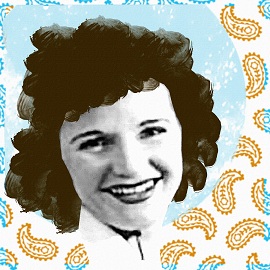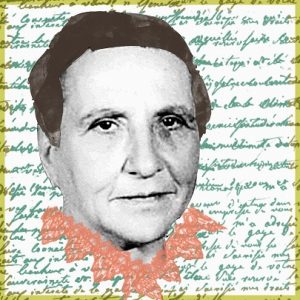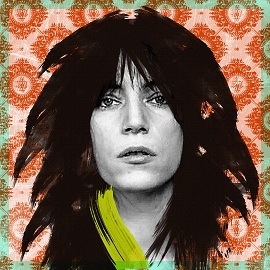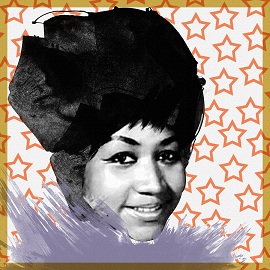If you subscribe to early ‘90s gender theory, men and women hail from different planets (Mars and Venus, respectively). But when it comes to leaving their mark in the arts, there’s no disputing that the recognition goes two ways. Whether it’s Clara Bow gracing the silver screen in her cupid-lipped glory, or the works left by Sylvia Plath—which, after the oven debacle, made her the first poet to win a Pulitzer posthumously—women have, through history, shaped the arts in ways that are embedded in our subconscious. They are the reason why we can’t look at a subway grate without also picturing a white dress (Marilyn Monroe), have a single name at our lips at the sight of a unibrow (Frida Kahlo), or look at a cone-shaped bra and not complete the image with astoundingly toned arms (Madonna). Immortalized through their works and achievements, the women below took Helen Reddy’s words (“I am woman, hear me roar”) to heart and for this year’s International Women’s Day on March 8, we are honouring them.
Orlan
An artist among artists, Orlan considers the operating room her studio. She deconstructs our ideas of beauty by serving herself up as the canvas—having volunteered her body for many unnatural alterations. A self-described neo-feminist, she had nine plastic surgeries
in the early ‘90s, which referenced beauty in traditional western art. Some of her alterations include implants to mimic the Mona Lisa’s protruding forehead, changing her mouth to look like François Boucher’s The Rape of Europa, and modifying her chin to look like The Birth of Venus by Botticelli. Born in 1947 in Saint-Étienne, Loire, Orlan first engaged in this form of surgery-art when she was preparing to speak at a symposium in 1978 but had to be rushed to hospital. She almost died because of an ectopic pregnancy (where the fetus is outside the womb and cannot survive), but while the surgeons were removing the fetus to save Orlan’s life, she insisted that she remain conscious and that the film crew she brought with her be able to film it. The images on film inspired her career. Orlan is a well-known multimedia artist in France and her work questions whether what we project is a reflection of our real selves, or a fabrication based on what is seen in the media. Her interest in cosmetic surgery has seen her labeled as anti-feminist by some, but the unique product of her alterations are clearly only cosmetic in name.
– Elysha Del Giusto-Enos
Patsy Montana was the first woman in country music to sell a million records with her 1935 single “I Want to be a Cowboy’s Sweetheart.” But, with that face and that yodeling, who wouldn’t want to be her sweetheart? The single also became a mainstay on the National Barn Dance on Chicago radio station WLS for many years, station of which she was a cast member in the early ‘30s. She was influenced by the music of “America’s Blue Yodeler” Jimmie Rodgers, and as a child she learned to yodel and play organ, guitar and violin. Montana was also a star of the stage; she appeared in numerous western films, including one with the “Singing Cowboy” Gene Autry. Her success in the music and film industry encouraged the traditionally male-oriented country music business to welcome and respect the female performers that followed her. She was known for making extensive tours and played many radio engagements during the ‘40s. Women in those days weren’t supposed to travel alone without their husbands or a male family member, but this was not going to stop this cutie from moving forward. She did it anyway and broke some ground by doing this. Yes, she was that badass. Montana’s intricate yodeling inspired many other female singers throughout the years and she was elected to the Country Music Hall of Fame in 1996, the year she passed away and became a yodeling angel.
– Giselle MacDonald
Phoebe Greenberg
Phoebe Greenberg is an innovative force behind the arts in Montreal. Not only has she founded the DHC Gallery, the theatre company Diving Horse Creations and the PHI Centre, but she is also a film producer, most notably working on the 2010 Oscar-nominated Incendies. Greenberg studied theatre at Concordia University before moving to Paris to study under Jacques Lecoq and work with LEM (Laboratoire Étude du Mouvement). On her return to Montreal in 1990, she started Diving Horse Creations, which offers parody-based theatre that is quite unique, integrating visual art, theatre and the great classics into original productions. She founded the DHC Gallery in 2007 and it has since become, according to tourism website The Montreal Buzz, one of the city’s go-to destinations for contemporary art. The gallery aims to provide a platform for young Canadian artists, but also attracts works by world-renowned artists such as Marc Quinn and Jenny Holzer. Greenberg’s current project is the PHI Centre, which will open its doors in the spring of 2012. The PHI Centre’s purpose is dedicated to fostering, producing, promoting and distributing original, artist-driven projects. Greenberg’s passion and dedication to serving all of the different facets of Montreal’s artist community make her a true woman of the arts.
– Amanda L. Shore
Sophia Loren
Sophia Loren’s life makes the scandals and achievements of modern-day stars pale in comparison. After all, how can a coke-induced breakdown compete with being involved in a bigamy scandal, rejecting a marriage proposal from Cary Grant and racking up 50 international awards for your acting in the process? Breaking out in the ‘50s, Loren quickly became the most famous Italian actress in the world, making heads in Hollywood turn with her wit and exotic beauty (in her earlier films, her name appeared as Sofia Lazzaro because people said her looks could raise Lazarus from the dead). Her strong chemistry with actor Marcello Mastroianni gave way to 14 films together, making them one of the most realistic couplings ever captured on camera. Yet she was devoted to her husband, film producer Carlo Ponti, who was 22 years her senior—they met when she was 14 and he was a judge in a beauty pageant she’d entered—and whom she married twice because of the aforementioned bigamy situation. She stayed with him until he died. If the names of her contemporaries are delicately written in the history of cinema, Loren’s is positively gouged in. Whether she’s portraying a prostitute to Mastroianni’s commitment-phobe player in Marriage Italian Style, a protective mother in the harrowing Two Women, or a countess in Charlie Chaplin’s last film, A Countess from Hong Kong, Loren’s screen presence is powerful and unforgettable, with her fierce gaze practically being seared into your mind. After all, what else could you expect from the woman who famously credited her body to spaghetti?
– Sofia Gay
Brie Neilson
The lovely and talented singer-songwriter and painter Brie Neilson does not have to do much to make an impact on the musical community as her creamy alto voice does it for her. One lady with a guitar is not a new musical formula, though Neilson has managed to make it a category of her own. Unlike the angst that can sometimes accompany a woman going solo, Neilson’s music resonates with thoughtful lyrics and beautiful melodies that allow the listener to enjoy her music without feeling obliged. Beyond her solo work, which you can now hear backed by her band, Brie Neilson and Her Other Men, Neilson also lends her voice to the 10-man gypsy-circus-folk band (never ordinary!) The Unsettlers. It was her friend B.W. Brandes, the frontman of The Unsettlers who, long before the band had come to be, encouraged Neilson to nurture her songwriting talent. But why stop at voice? Neilson is also a talented painter. Her interest in art began during childhood after finding she was not as adept at sports as she would have liked. Expressing herself in other activities such as finger painting and choir, the artist inside had begun to bloom. After attending the Emily Carr Institute of Art and Design in Vancouver, she supported herself by selling oil paintings of flowers for a commission. Never one to be ordinary, Neilson’s floral paintings go beyond what the average eye sees in a flower: “My interest in taking familiar objects and examining them in a new way, allowing the viewer to re-encounter them—close up, out of context and re-framed—is an ongoing objective in my painting.”
– Sara King-Abadi
Gertrude Stein
To the American ex-pats living in Paris in the ‘20s and ‘30s, she was an editor and a mentor; to emerging and innovative painters like Picasso and Matisse, she was a midwife who helped to shape and guide their artistic ventures; to those across the globe who read her works and were intrigued or disgusted by her non-linear, non-grammatical experimentation with the English language, she was a literary curiosity. Pop history might venture to call Gertrude Stein something akin to a “tastemaker” for a generation, but although the modernist works she produced and encouraged are now part of widespread taste and considered classics, Stein is perhaps best described as someone who helped the artists around her realize their capacity to move forward into a new moment in art, take risks and explore the limits of their self-expression. Working from her Paris salon, where she bought Picasso and Matisse pieces long before they were worth millions of dollars, she edited and mentored such greats as F. Scott Fitzgerald and Ernest Hemingway. With her partner, Alice B. Toklas, she amassed an art collection that showcased the best of modern art, and which will be shown in an upcoming exhibit at the Metropolitan Museum of Art in New York City, entitled The Steins Collect. She was an artist in her own right as well, penning, among others, the poem Tender Buttons, the experimental written style that plays on the musicality and tonality of language, as well The Autobiography of Alice B. Toklas, written from Alice’s perspective, but providing invaluable insight into the history of one of the most exciting moments in 20th century art and literature history. Although editors of her anthologies often joke about the pervasiveness of “Steinese” in modern artistic expression (think of sayings like “a rose is a rose is a rose”), the truth is that Gertrude Stein shaped the art of a generation, and the tastes, attitudes and culture which arose with and after it.
– Rebecca Ugolini
Mayim Bialik
Actor, writer, neuroscientist, spokesperson, mother, certified lactation educator counsellor, co-founder and chair of the youth branch of the Jewish Free Loan Association are just a few of the labels Mayim Bialik can be headed under. Best known for starring as Blossom in the 1990s sitcom of the same name and currently as Dr. Amy Farrah Fowler on The Big Bang Theory, Bialik is a highly regarded member of the arts community. Her first book comes out March 6, and when she’s not busy writing or acting, she’s taking care of her two boys. The horrible tales of what happens to child actors after their shows end have been assuaged slightly by Bialik’s amazing success story. Not only is she an exceptional actor, but she represents the myriad of possibilities available to women, proving that you don’t have to stay within a label, and that you can do virtually anything you want. Bialik currently holds a PhD in neuroscience and is consistently getting involved in new projects. She represents a woman who not only wears many hats, but excels in everything she’s involved in.
– Amanda L. Shore
Patti Smith
Where does one begin to describe Patti Smith? You could list the many endeavours she’s taken on—artist, poet, singer, playwright, author, actress, music critic—or maybe name drop the famous individuals she’s rubbed elbows with, including Salvador Dali, Jimi Hendrix, Allen Ginsberg, Janis Joplin, Sam Shepard and dozens more. But even that wouldn’t quite cover it. Smith’s story is riveting, from her exodus to New York City in the ‘60s after giving up her child for adoption and promising Joan of Arc’s statue in Philadelphia that she’d make something of herself, to touring the world with her band as The Patti Smith Group, earning the moniker “Godmother of Punk” for her unique hybrid of poetry and rock. She had an intense relationship with controversial photographer Robert Mapplethorpe—which she recounted in 2010’s Just Kids—and was a presence in legendary ‘70s New York City landmarks, such as the lobby of the Chelsea Hotel and CBGB. An artist through and through, her decades-long career led her to an induction into the Rock and Roll Hall of Fame and the title of Commander from the Ordre des Arts et des Lettres, the highest honour France bestows to artists. Her debut album Horses—for which Mapplethorpe photographed the iconic cover—has been featured prominently in many “greatest albums of all time” lists, including Time magazine and Rolling Stone. Perhaps what makes Smith such a remarkable artist is her dedication. The ‘80s saw her with a husband and kids, away from the spotlight. But when she came back, she did so by touring with Bob Dylan, putting out more albums and scribing more poetry. Needless to say, Joan of Arc would be proud.
– Sofia Gay
You’d be wise not to mess with Aretha Franklin. She demanded R-E-S-P-E-C-T in the ‘60s, a less-than-idyllic era for African Americans. Poet Nikki Giovanni called Franklin “the voice of the civil rights movement, the voice of Black America.” “Respect” remains her biggest hit and solidified her spot as the original sassy sister. She was the first woman to be inducted in the Rock and Roll Hall of Fame in 1987; she is the winner of 18 Grammy Awards and the recipient of two honorary Grammys, the Legend and the Lifetime Achievement. Forty-five of her singles have reached the Top 40. Her influence on the industry and artists who have followed in her pioneering footsteps cannot be ignored. There would not have been a Whitney, a Mariah, a Mary J., to name a few, if it weren’t for Aretha. In the No. 9 spot, she is the highest-ranked female on Rolling Stone’s 100 greatest artists of all time list (the next woman on the list is Madonna at No. 36). What makes Aretha a super special woman, though, is that her career started as a girl at age 14 in 1956. She is pushing 70 and released an album in 2011 through her own record company, Aretha Records, which she launched in 2004. In the immortal words of Ms. Franklin herself, sisters are certainly doin’ it for themselves.
– Chris Hanna
Graphics by Maya Pankalla












